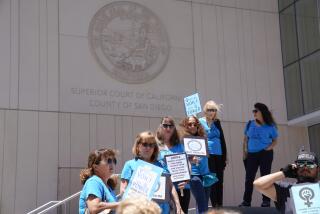Diversion of Violators Is ‘Epidemic’ : Justice: In 1992, thousands of parolees avoided court and were disciplined by parole officials after arrests for violent crimes. State panel decries scope of practice.
- Share via
About half of California’s prison inmates are parole violators who were arrested and sent back to the penitentiary. But most were not prosecuted.
During the last two decades, records show, only 1 in 4 parolees in prison was sent there by the courts. The rest were returned by parole authorities--a practice that continues today outside the reach of the “three strikes” law.
While the courts can impose up to a life term under the new law, parole officials can give only a maximum one-year penalty, no matter how serious the parolee’s current arrest or how numerous his prior convictions.
Statewide, about 8,800 parolees in 1992 were arrested for violent crimes such as murder, rape and robbery. Yet about two-thirds avoided criminal prosecution and instead were disciplined by parole officials. These unprosecuted parolees included 141 accused of homicide and 1,203 accused of robbery.
A report on the state’s criminal justice system in January pointed out that parole violators have reached “epidemic proportions,” putting a severe strain on the system.
It warned that the long-established practice of prosecutors to divert parolees away from the courts was a convenient but ill-advised method to dispose of thousands of cases.
The result, according to the report by the state’s Little Hoover Commission, is that “criminals who should be punished for their new crimes escape with a light sentence. . . .”
“Three strikes” has created a huge difference between the amount of prison time the courts and parole authorities can impose on offenders.
Under the old sentencing laws, for example, the low term for a felony drug conviction was 16 months. Under “three strikes,” a felony drug conviction for a defendant who already has accumulated two prior strikes could bring 25 years to life.
Prosecutors say they evaluate parolee arrests just like all others--filing charges in court when they believe they can prove them beyond a reasonable doubt.
In 1992, the most recent year for which comprehensive data is available, about 24,000 parolees were returned to prison by parole authorities--about 6,000 more than were prosecuted and sent back to prison by judges.
Of these 24,000, hundreds were the result of referrals from prosecutors. State Department of Justice records show that the vast majority of such cases come from Los Angeles County.
The Little Hoover Commission found that most parolees actually receive prison terms of less than one year. In 1991, the average prison term meted out by parole authorities was 7.3 months.
The report recommended that parole authorities be empowered to hand down prison terms longer than the one-year maximum.
More to Read
Sign up for Essential California
The most important California stories and recommendations in your inbox every morning.
You may occasionally receive promotional content from the Los Angeles Times.










